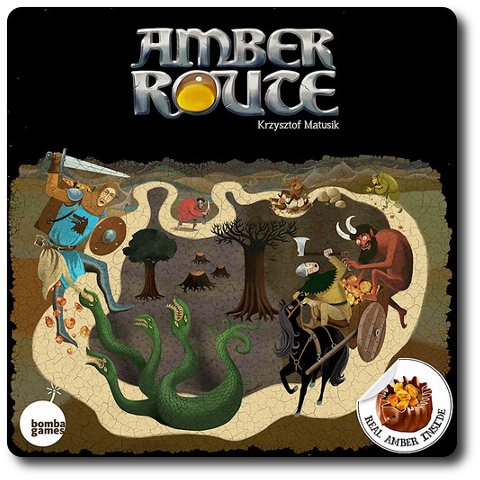
The Basics:
- For ages 7 and up (publisher suggests 8+)
- For 2 to 4 players
- Variable game play length
Geek Skills:
- Counting & Math
- Logical & Critical Decision Making
- Pattern/Color Matching
- Risk vs. Reward
- Hand/Resource Management
Learning Curve:
- Child – Moderate
- Adult – Easy
Theme & Narrative:
- Some roads should not be taken
Endorsements:
- Gamer Geek rejected!
- Parent Geek approved!
- Child Geek approved!
Overview
Amber can be used in jewelry, perfumes, and medicines. No wonder merchants are willing to risk the open road and dark forests to bring their amber to the market. But the roads have become more dangerous as of late. Monsters and supernatural creatures can be found stalking travelers. Sighing, you start walking. No one ever said a merchant’s life was easy.
Amber Route, designed by Krzysztof Matusik and published by Bomba Games, is comprised of 5 standard six-sided dice, 4 wooden Player pawns, 42 Power cards, 60 Encounter cards, 4 Aid cards, 4 Player cards, 40 amber pieces (as in real amber), 1 cotton bag (to hold all that amber), 32 Escort tokens, and 26 board elements. The component quality is excellent and providing real amber pieces is a neat touch that fits both the game’s theme and the game play. The illustrations by Roman Kucharski blend old traditions with new flare, capturing the game’s Slavic mythology and legends in both a colorful and whimsical way.
Preparing for Your Journey
To set up the game, give each player 1 Player pawn and 1 Player card that have matching colors. Give each player 1 Aid card at this time, too, if necessary. Any Player pawns, Player cards, and Aid cards not used go back in the game box.
Second, give each player 3 Escort tokens and 1 piece of amber (the size of the amber does not matter). These are all placed in front of the player. The remaining Escort tokens should be placed to one side to create the Escort supply. Leave the remaining amber pieces in the cloth bag and set it next to the Escort supply. Place the dice next to the Escort supply, as well.
Third, the board elements consists of 3 primary pieces. These include the Baltic Sea board element, the Road board elements, and the Castle board elements. All of the board elements are cut like puzzle pieces with the Road board elements fitting between the Baltic Sea and the Castle to form a rectangular board. The board elements can be mixed and matched in many different ways, allowing for customization of the game’s length and difficulty. The rule book provides a suggested set up for first time players, but there is no wrong way to go about it. Place the Baltic Sea board element on one end of the playing area and attach to it any number of Road board elements. The last board element attached is the Castle board element. Additional set up suggestions can be found under “Game Variant”.
Fourth, shuffle the Power cards and the Encounter cards separately. Place both decks face-down next to the game board. These are the Power and Encounter draw decks for the duration of the game.
Fifth, deal 5 Power cards to each player. These cards are the player’s starting hand. Players should keep their cards hidden from opponents until played.
Sixth, all players place their Player pawn on the Baltic Sea board element and then roll a die to determine who the first player is.
That’s it for game set up. Time to begin our journey.
Amber: The Cause of and Solution to All Your Problems
The goal of the game is to collect as much amber as possible, while simultaneously not allowing opponents to get ahead of you on the road to the Castle. This is where it gets a bit tricky. A player can only move one direction on the route, meaning that every step forward is one less opportunity to encounter a board element that was moved through. Encountering what each board element contains is the only way to collect amber, which means a player must not only pace themselves, but willingly put themselves in danger.
When amber is collected, it’s placed next to the Player card. This amber is unprotected and could be stolen. When the player collects 3 amber pieces, they take 1 of the amber pieces and place the other 2 back in the cloth bag. The 1 amber piece that is kept is placed on the Player card. This amber piece is safe from theft and can never be lost or taken. These secured amber pieces also award the player victory points at the end of the game.
A Quick Word on Power and Encounters
Power cards represent the people and things the players will encounter on the road from the Baltic Sea to the Castle. These are the “good guys” who will be helping the player on their journey. Power cards have two characteristics. Each Power card has a power level, with values 1 through 3. The other characteristic lists a specific terrain. Woods and mountains, for example. If a Power cards lists a terrain, that specific Power card can only be used by the player if their Player pawn is currently located on a board element that matches the Power card’s terrain symbol. If no symbol is present, the Power card can be used on any board element.
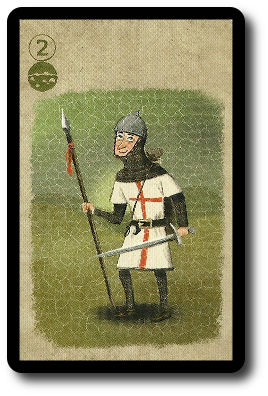
Encounter cards represent that nasty things the players will find on the road. Specifically, traps, ghosts, and monsters. The Encounter cards have a Terrain symbol and an Encounter symbol that is used to determine what the player will encounter when they move on the board elements. Encounter cards also have a Reward symbol that identifies what the player can earn if they successfully defeat the encounter. Finally, the Encounter card could have a Timing symbol that identifies when the Encounter card is used. Lighting bolts indicate immediate use, while an hourglass indicates the Encounter card’s reward is collected by the player and used later in the game.
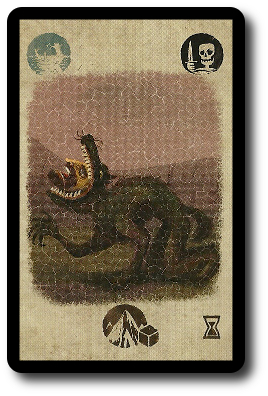
A Road Full of Danger
Amber Route is played in turns with no set number of turns in the game. A player’s turn consists of 2 phases which are summarized here.
Phase 1: Power or Protection
The player must decide if they want to draw 1 Power card, adding it to their hand, or grab an Escort token from the supply and place it with any other Escort tokens they currently have. Players cannot have more than 7 Power cards during their turn (must discard down to 7 if they do) and no more than 6 Escort tokens can be had.
Phase 2: Take One Action
The player must now take 1 action of their choice. There are several options to choose from. Each are summarized here, but only 1 action can be taken per turn.
Action Option: Recruit One Escort
This action allows the player to collect 1 Escort token from the Escort supply. If the player collected an Escort token during phase 1 of their turn, they may collect another if they select this action. If the player is located on a “Village” Road board element, 2 Escort tokens are collected.
Action Option: Draw Two Power Cards
This action allows the player to draw 2 Power cards and add it to their hand, but at a cost. The player must discard 1 amber piece, placing it back in the cloth bag. The player can then draw 2 Power cards. If the total number of Power cards in the player’s hand is greater than 7, they must discard down to no more than 7.
Action Option: Travel and Conflict
Players always move away from the Baltic Sea board element towards the Castle board element. Each board element between is considered 1 “block”. A player can move their Player pawn 1 block forward for free. The player can move their Player pawn a second block forward by discarding 1 Escort token back to the Escort supply.
Then the player encounters the block they ended their movement on. Note that a player only encounters a block when they move. If the player elected to draw a Power card or collect an Escort token, they do not encounter the block they already occupy.
Each board element has a Terrain symbol and an Encounter symbol. The player draws 1 Encounter card and determines how many symbols on the board element match the Encounter card.
- If both the Terrain symbol and the Encounter symbol match on the Encounter card and the board element, the player just walked into what will be a legendary battle (or defeat).
- If only 1 symbol matches on the Encounter card and the board element, the player will be faced with a difficult challenge.
- If none of the symbols match, the player is lucky and will have a relatively easy challenge to overcome.
The level of difficulty is based on how many symbols matched on both the Encounter card and the board element. The more symbols that matched, the more difficult the encounter. However, the bigger the risk, the greater the reward. Each type of encounter (ghost, monster, and trap) has special rules that modify how a player goes about overcoming the obstacle thrown in front of them. Each encounter type is unique enough to warrant some critical thinking by the player.
Monsters are vicious and use their strength and damage to hinder a player’s progress. A player can discard Power cards with a Terrain symbol that matches the current board element location to add dice. In fact, they will most likely have to because it takes several hits to kill a monster. Dice are then rolled and compared to the Monster chart to determine how many hits were inflicted on the Monster and how many Escort tokens the player loses. If the player loses all their Escort tokens before the Monster drops, they lose and must give up one amber piece. If they win, they earn the reward listed on the Encounter card.
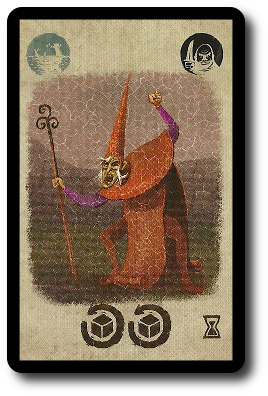
Ghosts (and undead in general) are supernatural and cannot be attacked head-on like a Monster. Instead, a player must avoid the Ghost by sneaking by them. This is done by again spending Power cards to add more dice and using Encounter tokens to manipulate dice values rolled. If the player successfully sneaks by, the rewards listed on the Encounter card are theirs. If they fail, the player will lose Power cards and possibly amber pieces.
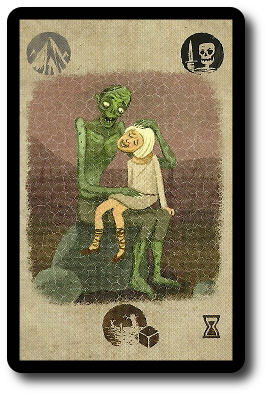
Traps litter the route to the Castle. Traps include pits, snares, and unnatural things that will attempt to slow the player’s progress. To avoid the Trap, the player must roll 2 or more dice with the same value. Power cards can be used to add more dice and using Escort tokens is a must if the player is to succeed. If the player successfully avoids the Trap, they are given the reward listed on the Encounter card. If they fail, the player loses 1 turn for every missing die value.
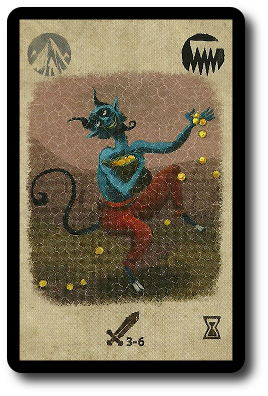
Players can also find fortune on their way to the Castle. These encounters give the player 6 possible outcomes that are always beneficial. From being rewarded a Power card to earning an amber piece. These Encounter cards are intermingled with the Monsters, Ghosts, and Traps, making each step on the road dangerous, but also potentially very beneficial.
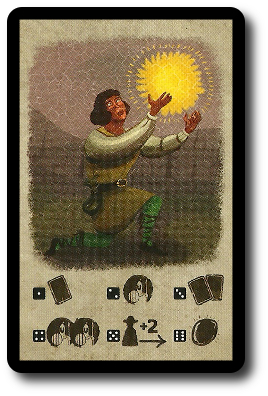
If the player is successful and they end their turn in a new block with a Village, they receive 1 Encounter token. If they end their turn on the Castle, they receive 1 amber piece.
Bonus Action Option: Attack Opponent
If the player successfully defeats the encounter, and an opponent’s Player pawn is located in the same block as the player’s, the active player has the option to attack their opponent. To do so, the player discards a Power card with a matching Terrain symbol. A battle then ensues with players discarding Power cards and using Escort tokens to adjust die values. The loser of the battle loses 1 amber piece to their opponent.
This ends the player’s turn. The next player in turn order sequence now takes their turn.
The End of the Journey
The game continues until 1 player reaches the Castle board element. There is nothing to encounter at the Castle, meaning the player’s turn is now over, but the player does receive 1 amber piece as a reward. All remaining players are given 1 last turn before the game ends.
When the game ends, it’s time to count victory points. The player who reached the Castle first is awarded 5 victory points as a bonus. Then all the players earn 3 victory points for each secured piece of amber on their Player card and 1 victory point for every Encounter card they did not use for the reward. Then each player who DID NOT reach the Castle reduces their total victory points by -1 for each block between them and the Castle.
The player with the most victory points wins the game.
Game Variant
The modular design of the game boards allows players to mix and match the different board elements to create longer and shorter routes between the Baltic Sea and the Castle. Players are welcome to create their own and 3 additional set up options are provided in the game rules. These are shown here. Just match what the image depicts and you are all set.
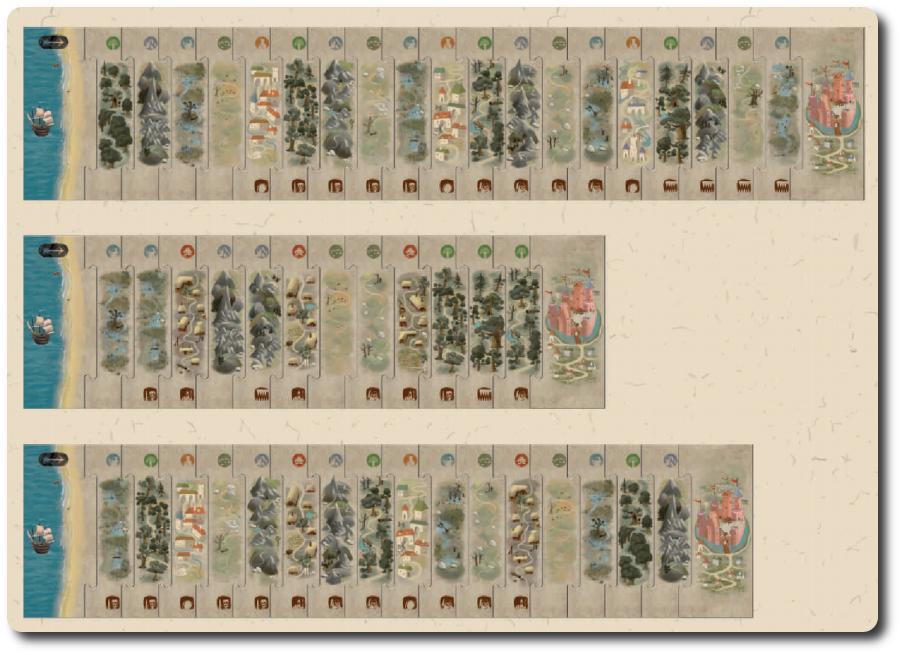
House Rule
None of our players liked the rules that allowed players to attack other players. Most of the Parent Geeks and all the Gamer Geeks found the player-versus-player aspect of the game play to be disruptive and unnecessary. Only a few of the Child Geeks liked that you could attack an opponent, but quickly changed their statement when they were being attacked. To resolve what many of our players saw as a flaw, we removed the ability for the players to attack one another. This did not upset the game play or player balance. Removal of the rule, however, meant that players could not directly hinder an opponent who clearly had the lead.
To learn more about Amber Route, visit the game’s web page.
Final Word
The most difficult aspect of the game, and why the learning curve for children is “moderate”, is the heavy amount of dice manipulation required to be competitive. Resolving encounters in Amber Route is a random exercise of flipping cards and rolling dice. Through the use of Power cards and Escort tokens, the players can improve their odds and manipulate values. This was not a difficult concept for the Child Geeks to grasp, but no observers could suggest that the Child Geeks fully understood it either. According to one Child Geek, “I know I can change the dice or add dice, but I keep forgetting how and when I should.” If the Child Geeks only played the game once, I wouldn’t mention it, but after 5 game plays some of the Child Geeks were still forgetting. Another aspect of the game that slowed the Child Geeks down was the many symbols used in the game. The Child Geeks needed to pause the game often to look up the meaning of a symbol. Not a problem, but it became something of a joke that each player was passed the rule book when it was their turn. As one Child Geek put it, “I wish the symbols were on the back of a sheet with words instead of just a cards with no explanation.” Despite these two hiccups, the Child Geeks really enjoyed themselves. They loved the illustrations, the real amber pieces, and the suspense of seeing what they encountered on the road. When all the journeys were over, the Child Geeks decided the trip was well worth it.
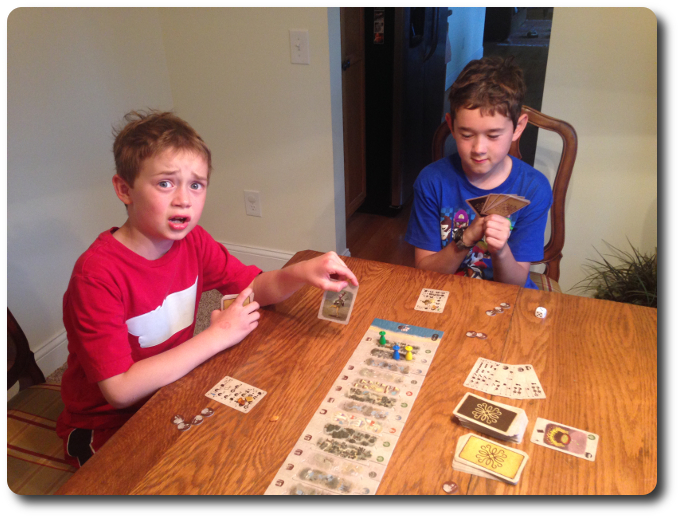
My son once again expresses his growing confusion (but never frustration) regarding the odd artwork on the cards
The Parent Geeks had difficulty learning the symbols, as well, but caught on much faster than the Child Geeks. Overall, the Parent Geeks liked what the game was about and its light game play. According to one Parent Geek, “The game is pretty casual, not very deep, and easy to play. I like all the different ways you can manipulate rolls to reduce the level of randomness.” Another Parent Geek said, “Visually, the game is wonderful, although I am left wondering what and who many of these characters and creatures are. The game play is a bit tricky to understand at first when it comes to your first battle, but you quickly learn it. I like the game. It’s unique.” None of our Parent Geeks cared for the player combat, finding it to be more of a disruption than an integral part of the game play. When all the games were over and the amber safely delivered, the Parent Geeks gave Amber Route two thumbs up.
The Gamer Geeks liked the game’s presentation, but found the game play to be wonky. As one Gamer Geek put it, “Everything is random in this game. All I can do is reduce my odds of losing, but not remove the randomness. That’s annoying.” Another Gamer Geek said, “This is nothing more than a race game that purposely slows its players down. The only part about this game I am really enjoying is the artwork. Everything else is forgettable, but playable.” Another Gamer Geek summed it well when he said, “This game has great presentation and an interesting concept, but is too dependent on luck and has almost no depth.” All the Gamer Geeks voted to reject Amber Route.
The artwork in this game is bizarre and amazing. The images range from grotesque and other worldly to whimsical and playful. Each image begs to be explained since what is depicted is a tantalizing snippet of a story that looks to be an interesting tale. For example, there is an image of a forest with eyes where 3 figures are on their knees before it, a shirtless mountain man with a stick that is all too happy to assist the player, and multiple images of demons and devils. It’s important to remember that Slavic mythology and folklore is a mix of very old religious beliefs intermingled with Christianity. Most of the traditions and religious rites were passed down using oral lore. Knowing this, is it any wonder that the Slavic myths and folklore we read today seem to be from another time and another place? The game’s artwork captures this other world perfectly and remains a topic of discussion well after the game is put away.
But therein lies part of the game’s weakness. It’s the illustrations that players remember, not the game play.
Amber Route is not very deep, strategic, or tactical, as the Gamer Geeks have already mentioned. The game is one part racing and one part resource management. Where the two parts merge requires players to manipulate values and dice using Power cards and Encounter tokens, but a lot of our players found this to be fiddly. To which, I must begrudgingly agree. Since everything starts with a random draw or a roll, the player’s next step is to always manipulate what is shown. This does slow down the game, but not terribly, and players shouldn’t rush this step, either. In order to go forward, players must manipulate cards and dice to achieve a beneficial outcome. The game is most certainly a race, but not a very fast one.
While Amber Route is not necessary targeting the family gaming table, I think that is where the game is best played. It’s good fun for the Child Geeks and deep enough to keep the casual gamers interested. Its modular game board pieces allow players to set the length of the game and tailor it to their audience. This makes Amber Route one of those games that can be customized for different families and player skill levels, making it an easy game to get to the table.
I’ve played better games, but Amber Route is by no means a game to avoid. It has its faults, but its strengths and uniqueness make any blemish it might have fade into the background. An interesting game, with imaginative artwork, and lots of critical thinking. Amber Route is sure to please those looking for a casual game with visual appeal that challenges a player to use their resources wisely. If this game sounds interesting to you, do sit down and give Amber Route a try.
This game was given to Father Geek as a review copy. Father Geek was not paid, bribed, wined, dined, or threatened in vain hopes of influencing this review. Such is the statuesque and legendary integrity of Father Geek.




How do you think it holds up today? Have you gone back to it? It has low ratings on BGG but I find it attractive looking.
Not a game I continue to go back nowadays.